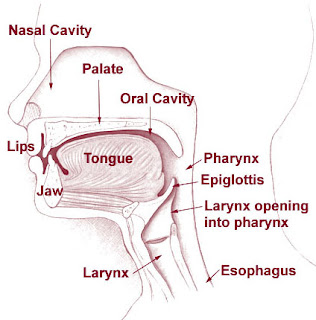The Organs of Speech
The organs of human body
which produced speech sounds are called 'organs of speech'. The sound is
produced by the stream of air arising out of the lungs. This air passes through
various organs of speech and finally comes out in the form of different sounds
called speech sounds.
"Phonetics
is the scientific study of production, transmission and reception of speech
sounds"
It generally studies
the medium of spoken language touching upon physiology and physics. Phonetics is
now a pure science that studies speech processes including the neurology and
pathology of speech. It also relates to articulation, description,
classification, production, and perception of speech sounds.
Phonetics studies the
speech organs, which produces sounds of language, it studies waves, the
physical form in which sounds are transmitted through the air from one person to
another, and it studies the way in which human beings perceive sounds through
the medium of ear.
Phonetics try to study
the various organs of speech like the lungs, the larynx, the soft palate, the
tongue and the lips function in the production of speech. They also attempt to
offer articulatory descriptions of various speech sounds by describing the air
stream mechanism and the articulatory processes involved.
Organs of speech are mainly divided into three categories,
The Articulatory system
|
The Respiratory system
|
The Phonatory system - the
vocal cords
|
1. The Pharynx (throat)
|
1. The Lungs
|
1. The Larynx
|
2. The lips
|
2. The muscles of chest
|
2. The vocal cords
|
3. The teeth
|
3. The Trachea (wind pipe)
|
|
4. The teeth ridge
|
4. Bronchi - Bronchus
|
|
5. The Hard palate
|
||
6. The soft palate
|
||
7. The uvula
|
||
8. The tongue
|
1. The Articulatory system:
There are few organs of
our head and neck involved in the articulatory system, which is
called organs of speech. Lips, teeth, tongue, and the palate are from
this system. All this are important in speech. The roof of the mouth is divided
into four parts and tongue is divided into six parts.
Roof of the mouth includes
teeth ridge, hard palate, velum/soft palate, and uvula. The tongue includes a
tip, blade, front, centre, back, and root.
2. The Respiratory system:
This system lies from
neck to abdomen. The system has a work system like, the lungs receive oxygen
through bronchus, the bronchus joins the windpipes. When we take air from the
outer atmosphere, the air goes into lungs through the windpipe. The process of
taking breath in lungs is inspiration. The lungs expands when we breathe
in and when we breathe out, the air goes out from lungs then through bronchus,
it goes in outer atmosphere. This process is called expiration.
The respiratory system is important
part in organs of speech because air is necessary part of speaking, and we need
air for the process of speaking. For the most of speech sounds breathe out in
necessary and as per T. Balasubramanian,
"All the
speech sounds of English and several Indian languages (except sindhi) are
produced with the help of the air that we breathe out"
3. The Phonatory system:
This system involves larynx
and vocal cords. Below is the image of vocal cords and larynx's position
in the body. Vocal cords are attached at one end and left loose on the other
side so it can move freely. When they move away from each other there is a
space between them which is called glottis. The air passes through glottis
during the breathing process.
When we speak or produce speech sounds,
the vocal cords move far away from each other and the air passes through
glottis. These sounds are called voiceless sounds.
Here are some voiceless sounds,
[k] - school
[f] - feel
[h] - heat
[t] - stool
On the other side,
while producing some sounds, vocal cords are close to each other and when the
air passes through vocal cords it creates open and close rapidly, this is
called vibration. This process produces voiced sounds.
In English all the vowels are voiced. For example,
[m] - mean
[n] - need
[z] - zoo
[r] - rest
[w] - wheat
Apart from this, the
voiced and voiceless sounds help us in determining the pitch of our voice such
as high pitch and low pitch.
Here are two images of
vocal cords, when it is wide open and far away from each other, and closed to
each other.
Work cited
Balasubramanian, T. "A Textbook
of English Phonetics for Indian Students." Balasubramanian, T. A
Textbook of English Phonetics for Indian Students. n.d.









No comments:
Post a Comment